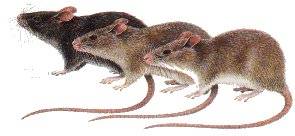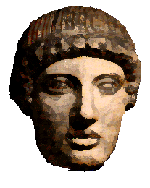Archaeology
Elsewhere
- Muslims dig Christian monastery
PALESTINIAN archaeologists have unearthed an undamaged fifth-century mosaic in the Gaza Strip at a site believed to be the location of the oldest monastery in the Middle East. Last week's find at Tal Umm Amer, four miles south of Gaza City, has been hailed as an archaeological discovery of great significance. The archaeologists working at the monastery are Muslim, but see nothing unusual about their desire to protect and promote a Christian shrine in an area inhabited by only a few thousand Christians. They hope that one day thousands of people will come to visit and appreciate their work in uncovering historical treasures. "This is our history; this is our civilisation and we want our people to know about it," said Yasser Matar, the co-director of the archaeological operation, as a burst of gunfire - echoing the region's troubles - sounded in the distance. "First we were Christians and later we became Muslims. These people were our forefathers: the ancient Palestinians." [Telegraph, 2 December 2001] - Found: the harbour that held the "Thousand Ships"
Helen of Troy's was (according to Marlowe)the face that launched a thousand ships. In search of her, where did those Greek ships land in Troy? Scientists, joined by a Greek scholar, discovered where Troy's harbor might have been. Kraft and his colleagues used the Iliad and the Geographies of Strabo, among other writings, to help them correlate their scientific findings and delineate the famous harbor. Kraft will present these findings on Wednesday, November 7, at the Geological Society of America's annual meeting, A Geo-Odyssey, in Boston, Massachusetts. "My research interests are focused on the relations of archaeological and historical sites to changes in coastal geomorphologies over the past 10 millennia--mainly in coastal Greece, Turkey, and Delaware," Kraft said. "When our sedimentary facies are correlated with details of the writings of Strabo (first century AD), we can identify possible locales of the allied Greek fleet harbor and fortifications as well as the harbors of Troy and the later New Ilium (new Troy). Strabo provides both distances and details of coastal morphologies that are compatible with RC-14 [Radio Carbon 14]dated coastal marine geometries determined by sedimentary analyses. Clearly, the product of historical and legendary writings of antiquity and (times) and our geological analyses of Holocene Epoch sedimentary environmental facies provide synergistic resultant ancient geographies." Geological Society of America - Ancient pollution detected - from Space
Sites of ancient metal working which may still be dangerous have been pinpointed by the space shuttle Endeavour. Buried slag-heaps and other dumps of unpleasant waste which had been covered with soil are clearly revealed by the 3D radar device. Health officials are now focusing on sites of Roman lead mines in the UK, while elsewhere remains of Greek and Phoenician mines will come under scrutiny. Environmentalists had long been worried that children could be harmed playing where soil is contaminated - now the detritus of the ancients will be as easy to detect as that of more recent polluters. [Independent on Sunday 20 February 2000] - Phoenician Tomb in Cyprus
The Phoenicians are the most mysterious of all ancient Mediterranean peoples (except possibly the Etruscans). But a tomb found by chance during excavation for a swimming pool at Larnaka is helping shed some light. It was an undisturbed (ie unlooted) stone chamber, dating to 750 BC. It contained gold objects (brooch, necklace, bracelets, rings, daggers and tweezers) - and a female skeleton, along with skeletons of three horses than had been sacrificed. Sacrifice of horses remind one immediately of the funeral of Patroclus in the Iliad - and also the tomb at Lefkandi in Euboea. Both these burials are roughly contemporary with the Iliad - could such funerals have been inspired by Homer? [The Guardian June 26, 1999] - Mummy! Mummy! Mummy!
It was all because a donkey put his foot in it. In western Egypt, where its archaeological masters had been sweating unrewarded for four years, the patient beast slipped and revealed a tomb dating from the Graeco-Roman era (330 BC - AD 400). Inside was not one mummy, not two, but 20 or more: altogether 105 have been found in the four tombs so far excavated. But there is is a vast tomb complex - covering over four square miles. It's estimated the total haul will be about 10,000 mummies - but many will probably be left in situ for archaeologists of the future with maybe more sophisicated techniques than a bored donkey! (only joking). For more info see the Egyptian Exploration Society or Egyptology at Cambridge. [The Times - article and pictures June 14th 1999] - New culprits for the Decline and Fall: rats!

Excavations in the ancient port at Unguja Ukuu on the island of Zanzibar suggest that the Romans' appetite for ivory indirectly caused the end of their empire, and the start of the dark ages. In the 6th century AD ivory from the abundant herds of African elephants was shipped to Justinian's court at Constantinople from Zanzibar - but on the outward voyage there were the usual stowaways: rats. These would have been black rats (rattus rattus) - whose bones have been found together with typical contemporary Mediterranean pottery. The black rat is not indigenous to Africa, and must have arrived on board ship - then fraternised with the local rodents (immune to the plague which their fleas carried). Then they got back on board, taking the plague back in the ships' holds along with the ivory. The plague arrived in Constantinople in 541 AD - and started killing up to 16,000 people a day. Byzantine officials stopped counting the bodies when the toll passed a quarter of a million. Within ten years it had swept across Europe, and the Dark Ages had begun. [The Times - article and pictures June 8th 1999]
- Dig damned!
Members of the Ultra Orthodox United Torah Judaism group - last heard of protesting about the victory of saucy transsexual "Dana International" in the Eurovision Song Contest - have persuaded Israeli PM Binyamin Netanyahu effectively to ban archaeology. All digs are now subject to their religious veto, and sites are being monitored to prevent any disturbance to Jewish bones. Cynics say that archaeologists will discover that most ancient bones belonged to Christians. (Guardian 30 June 1998) - Carry On Cleo, Underwater
French archaeologists have this week recovered a black granite sphinx from the harbour at Alexandria in Egypt. It has the unmistakable facial features (hooked nose and protruding chin) of Ptolemy XII Auletes (the"Flute Player") - father of Cleopatra. Together with recent discovery of remains of the Pharos and of the Royal Place, the newly-recovered sphinx has increased speculation that the whole underwater complex may be preserved in a sub-aqua museum, where visitors could walk through glass tunnels, or travel in a glass submarine to view the remains in situ. (Guardian 30 October 1998) - Herod's Palace in danger
 The amazing 1st century AD palace built by Herod the Great's engineers
on the vertiginous windswept northern end of the rock of Masada in Israel
(later to be made famous by the desperate defence against the soldiers
of the emperor Titus) is crumbling like a cheese. Holes in the soft
limestone walls need to be filled soon - otherwise the entire structure
will slide down into the valley below next time there's an earthquake,
or maybe just next time it rains. British archaeologists are leading
the rescue bid - in a race against time to save one of the more spectacular
architectural triumphs of the ancient world. It's at the far end of
the picture - which shows the remains of the ramp built by the Romans
to capture the last stronghold of free independent Jews - the last to
control any part of their country until 1948.(Guardian
28 October 1998)
The amazing 1st century AD palace built by Herod the Great's engineers
on the vertiginous windswept northern end of the rock of Masada in Israel
(later to be made famous by the desperate defence against the soldiers
of the emperor Titus) is crumbling like a cheese. Holes in the soft
limestone walls need to be filled soon - otherwise the entire structure
will slide down into the valley below next time there's an earthquake,
or maybe just next time it rains. British archaeologists are leading
the rescue bid - in a race against time to save one of the more spectacular
architectural triumphs of the ancient world. It's at the far end of
the picture - which shows the remains of the ramp built by the Romans
to capture the last stronghold of free independent Jews - the last to
control any part of their country until 1948.(Guardian
28 October 1998) - Herod, the first wine snob?
Herod the Great (c.73 - 4 BC), persecutor of the infant Jesus and owner of one of the most spectacular homes outside a James Bond film (see below), emerges - according to a new exhibition in Israel as a considerable wine buff. Despite the reputation of locally grown wines, he insisted on the best - from Italy, the Greek Islands, and Lebanon [whose Château Musar of more recent times I can confirm - as something of a wine snob myself - is a very fine drink indeed]. His wine cellar in his Masada palace has recently been excavated: the name of each vineyard duly inscribed on each ceramic jar. The exhibition - a light-hearted part of Israel's Millenium celebrations continues until January 2000. [The Times - article and picture Friday 28 May 1999] - The stripping of Albania
Classical art treasures, vulnerable to thieves and racketeers in that tragic country - once as rich as Greece in terms of its ancient, Roman and medieval heritage - are being sent to Greece for protection. Albanian museums have been looted and are, like most of her churches, desecrated and abandoned. Only the National Museum in Tirana is still trying to operate normally. Treasures from Butrint (Buthrotum) are now safe for the time being in Athens. (Guardian March 27th 1998) - Roman Secret Police HQ
It was widely reported in the press this week that Israeli archaeologists are interpreting a Latin inscription found in a building in ancient Caesarea as indicating that the building was the HQ of the Roman internal security services. If so, this could be where Paul of Tarsus aka St Paul aka Saul - any many other anti-Roman agitators were "interrogated". [Is it generally known why Saul changed his name to Paul? Paulus = "Tich" ,"Stumpy", "Shorty" from Latin meaning small might seem an undignified nickname, but must have been an improvement on his Jewish name once he started associating with Greeks: in Greek saulos means " wiggling the hips in a sexually provocative manner" - hardly a suitable monicker for the serious evangelist!]
The Latin mosaic says (quoted inaccurately in most papers - but the Times had a clear photograph):
BONA SPES ADIVI ORIB(VS) OFFICI CVSTODIAR appearing to mean "Good Hope. I have come to the entrance(jaws) of the office. I shall be looked after."
Professor Yosef Porath, director of the excavations reckons that he's found the admin centre for the province of Judaea, and the likely site of the trial of St Paul in 45 AD (he successfully appealed to Rome, on the grounds that he was a Roman citizen). Ironically, the current HQ of the Shin Bet, the Israeli secret police is today a mere 30 miles down the road. [Guardian September 10 1997] - Invitation to Paradise?
Classics lovers are invited to visit a country with superbly preserved Roman monuments, guaranteed sunshine, no crowds, no package tours, no noisy nightclubs (no nightlife of any kind), no British lager louts (alcohol is banned) - yes, a firm has been hired to promote tourism in - Libya. Form an orderly queue. If you've always wanted to know how many kisses were enough and more than enough for poor Catullus (Poem 7 - see my new version) now's your chance to count the grains of sand between Cyrene and the ancient tomb of Battus.[Guardian 25 August 1997] - Mummy's new face
The British Museum's Ancient Faces exhibition (on until 20th July 1997) has already been a brilliant success. These are the sloe-eyed young ladies and gentlemen who have found their way on to so many book covers (Penguin Classics Catullus, eg) - but nothing prepares you for the stunning freshness and "modernity" of the originals. There's a superb catalogue to go with the exhibition.[March 16, 1997] But it now has something even more remarkable to show. The portraits - anticipating artistic skills of the Renaissance by 1500 years, have been known since they were discovered by the great Victorian archaeologist Sir Flinders Petrie at Hawara in Egypt in 1888 (although we don't know precisely how their encaustic technique worked). Petrie originally had 60 skulls which matched the portraits - but these were believed lost. When Meredith Thompson went to a lecture last winter, given by Dr Paul Roberts of the British Museum who'd been assembling the exhibition of portraits - she was amazed to discover that she knew where some of the skulls were - on her desk!
So far so incredible: but it gets better. Two of the skulls were given to John Prag and Richard Neave in Manchester - experts on the reconstruction of faces from bones (Philip of Macedon is their masterpiece - but their expertise has also been used to reconstruct the faces of murder or arson victims). They built up models of the faces using their techniques - they were deliberately not shown the matching portraits. The results - particularly of the woman nicknamed Fatima - are absolutely startling. The match between the head and the portrait is uncanny, especially now she's been given a wig to echo the picture. There's a month left - on no account should you miss this exhibition. It seems to prove that these Romano-Egyptians really did paint portraits from life: and when else has it been possible to check a portrait of a dead person with the real thing? [UK newspapers 26 June 1997 - excellent pictures in Guardian and Daily Telegraph] - Hannibalism
Tunisia has woken up to the tourist potential of Hannibal. Previously the old warrior was ignored by a nation not eager to lay claim to anything before the arrival of Islam. Now, though, a more secular Tunisia is wishing to stress other aspects of her early history - exploring Greek, Roman and Berber connections as well as Punic. The "Hannibal Club" - charged with getting the project off the ground wanted to start by repatriating his bones: but Bithynia was not easy to locate. Nor does anyone know what he looked like - though I'm sure this won't stop him appearing on mugs, teatowels and other essential tourist paraphernalia. And wasn't he actually a bit of a loser? [The Guardian, April 11th 1997] - The Masada Myth
The traditional version of the fall of the stronghold of Masada in Israel inAD 73 is under fire. According to Josephus' story - famously endorsed by the original excavator in the 60s, Professor Yigael Yadin, - the heroic leader of the last Jewish resistance to the Romans, Elezar Ben-Yair, masterminded the suicide of 960 of his followers. But now a new and controversial interpretation of Josephus and the archaeological evidence suggests that the defenders of Masada were not heroic patriots, but a gang of murderers, followers of an illegal cult which had assassinated 700 local people and killed the High Priest in Jerusalem. Much is at stake - as Masada since the dig in the sixties has become a potent national symbol - recruits to the Israeli armoured corps went up there for their annual swearing-in ceremony.[The Independent on Sunday, 30th March 1997] - Amazons - amazin' discoveries
What we always thought was the ultimate Greek mens' fantasy - a race of warrior women desperate for a scrap with their male counterparts - may after all be based on reality. According to the New Scientist, an American archaeologist, Jeannine Davis-Kimball, has found women's bones together with used weapons (arrowheads, swords and daggers) in 2000 year old burial mounds belonging to a nomadic race in Central Asia (more or less where Herodotus located them). [Independent 6 February 1997] - Who killed the 100 babies?
A mass grave of over 100 infants (all under two days old) dating from 4th century AD has been found in a sewer near a Roman bath house in Israel. Is this evidence for the infanticide method of ancient birth control (but if so why were only about a quarter of them girls)? If the bath house was also a brothel, there is the possibility that the babies were the unplanned and unwanted offspring of the working girls (would explain why there are so many males).
Exposure of unwanted children was normal practice in the ancient world (not just something that happened to mythological characters like Oedipus). [Guardian 16th Jan 1997]

